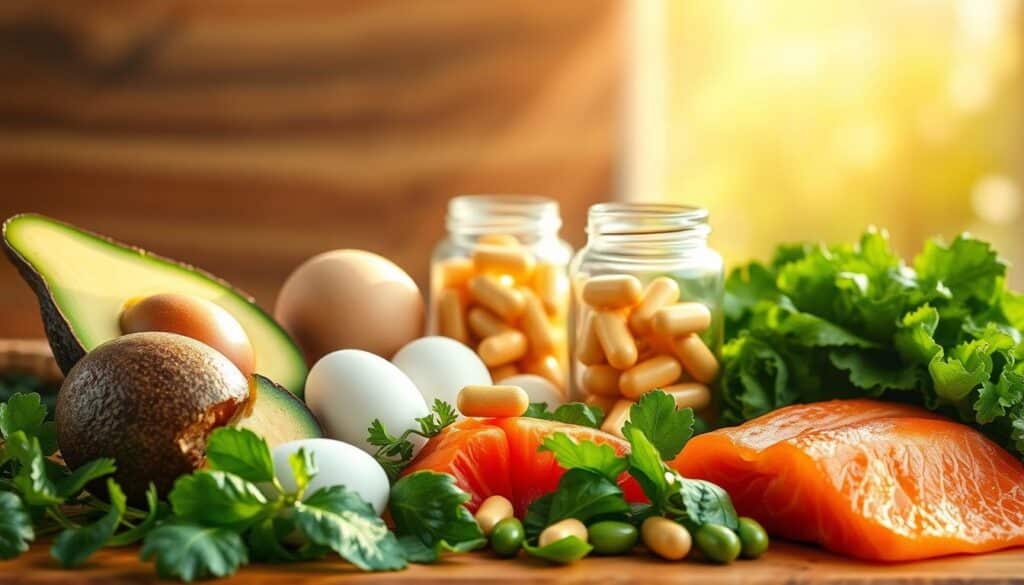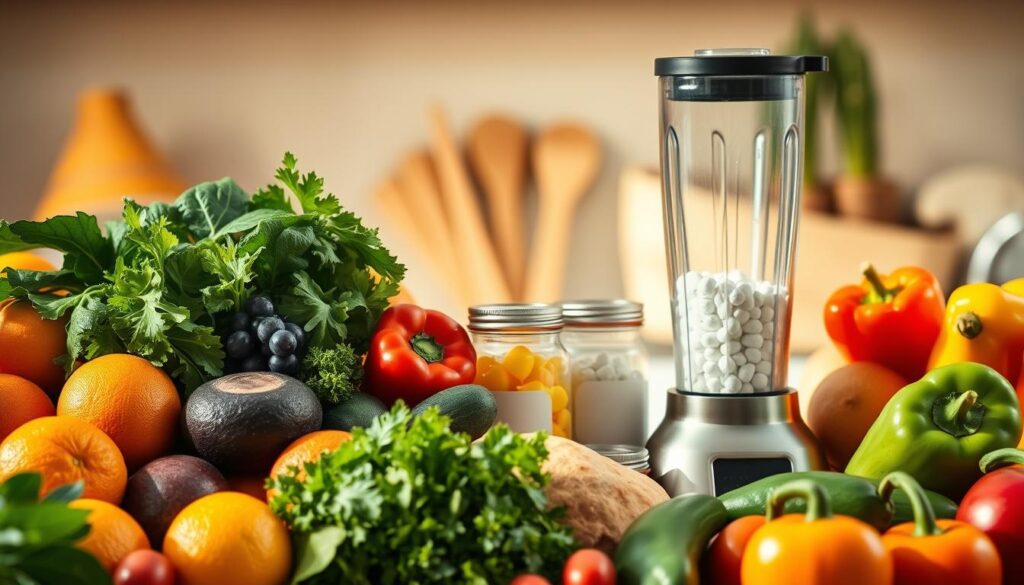Headaches can be debilitating, affecting daily life and productivity. While medication is often the go-to solution, incorporating specific foods into your diet can provide headache relief and reduce the frequency of episodes.
Eating the right foods can be a simple yet effective way to manage headaches. Certain nutrients and minerals play a crucial role in alleviating headache symptoms, and a well-balanced diet can help mitigate the severity of headaches.
Anúncios
By making informed dietary choices, individuals can take a proactive approach to managing headaches and finding natural pain relief. This approach not only helps alleviate headache symptoms but also contributes to overall well-being.
Key Takeaways
- Incorporating specific foods into your diet can help alleviate headache symptoms.
- A well-balanced diet rich in essential nutrients can mitigate headache severity.
- Making informed dietary choices is a proactive step towards managing headaches.
- Certain nutrients and minerals play a crucial role in headache relief.
- A dietary approach can contribute to overall well-being.
Why Headaches Happen and How Food Can Help
Understanding headaches is crucial to finding relief, and food plays a significant role in this process. Headaches can be triggered by a variety of factors, including dietary choices.
Common Types of Headaches and Their Causes
There are several types of headaches, including tension headaches, migraines, and cluster headaches. Tension headaches are often caused by muscle tension, while migraines can be triggered by hormonal changes and certain foods. Cluster headaches are severe and occur in clusters or cycles.
As
“The food we eat can either exacerbate or alleviate headache symptoms.”
Understanding the causes of different headache types is essential to managing them effectively.
The Food-Pain Connection Explained
Certain foods have anti-inflammatory properties that can help reduce headache severity. For example, foods rich in omega-3 fatty acids, such as salmon, can help alleviate inflammation. Additionally, staying hydrated by drinking plenty of water and consuming hydrating foods like cucumbers can prevent dehydration headaches.
Setting Realistic Expectations for Natural Relief
While dietary changes can significantly impact headache frequency and severity, it’s essential to have realistic expectations. Incorporating anti-inflammatory foods and avoiding trigger foods can lead to natural relief, but it may take time to notice improvements.
By understanding the connection between food and headaches, individuals can make informed choices to help manage their headache symptoms and improve their overall quality of life.
The Science Behind Natural Foods that Relieve Headaches
Understanding how certain foods impact headaches requires a look into their nutritional components. The relationship between food and headache relief is complex, involving various nutrients and their effects on brain chemistry, inflammation, and blood flow.
How Nutrients Affect Brain Chemistry
Nutrients play a crucial role in maintaining healthy brain chemistry, which is vital for preventing headaches. For instance, magnesium and riboflavin (B2) have been shown to influence headache frequency and severity. Magnesium helps in regulating neurotransmitter function and blood vessel constriction, while riboflavin is involved in energy production within cells, potentially reducing migraine frequency.
Inflammation: The Hidden Headache Trigger
Inflammation is a known trigger for headaches, and certain foods can either exacerbate or alleviate this condition. Foods rich in omega-3 fatty acids, such as salmon and sardines, have anti-inflammatory properties that can help reduce headache severity. Conversely, processed foods containing artificial additives can trigger or worsen inflammation.
Blood Flow, Vasodilation, and Pain Perception
The impact of food on blood flow and vasodilation is another critical aspect of headache relief. Foods that promote healthy blood flow, such as those rich in potassium (e.g., bananas, avocados), can help alleviate headache symptoms by ensuring proper vasodilation and reducing pain perception.
By understanding the scientific basis of how different nutrients affect headache occurrence, individuals can make informed dietary choices to help manage and prevent headaches.
Anti-Inflammatory Powerhouses for Pain Relief
To soothe headaches naturally, it’s essential to understand the role of anti-inflammatory foods. Incorporating these powerful ingredients into your diet can significantly reduce headache frequency and severity.
Omega-3 Rich Fish and Seafood Options
Fatty fish like salmon, sardines, and mackerel are rich in omega-3 fatty acids, which have potent anti-inflammatory effects. These nutrients help reduce inflammation in blood vessels and promote overall brain health. Including omega-3 rich fish in your meals at least twice a week can be beneficial.
Top Omega-3 Rich Seafood:
- Salmon
- Sardines
- Mackerel
- Anchovies
Turmeric, Ginger, and Other Healing Spices
Certain spices have been used for centuries for their anti-inflammatory properties. Turmeric contains curcumin, a compound known for its powerful anti-inflammatory effects. Ginger has also been shown to reduce pain and inflammation. Incorporating these spices into your cooking can be a simple yet effective way to enhance your diet’s anti-inflammatory potential.
Try adding turmeric to your morning smoothie or ginger to your tea for a delicious and healthy start to your day.
Colorful Vegetables and Their Protective Compounds
Colorful vegetables are not only visually appealing, but they’re also packed with antioxidants and other protective compounds that combat inflammation. Berries, leafy greens, and bell peppers are just a few examples of vegetables that can help reduce headache symptoms.
Key Colorful Vegetables:
- Bell Peppers
- Tomatoes
- Carrots
- Berries (such as blueberries and strawberries)
By incorporating these anti-inflammatory powerhouses into your diet, you can take a proactive step towards managing headaches and improving your overall well-being.
Magnesium-Rich Foods to Prevent Migraines
Incorporating magnesium-rich foods into your diet can be a game-changer for migraine sufferers. Magnesium plays a crucial role in many bodily functions, including nerve function and blood glucose control, which can impact migraine frequency and severity.
Dark Chocolate: A Delicious Remedy
Dark chocolate is not only a treat for the taste buds but also a good source of magnesium. Choosing dark chocolate with at least 70% cocoa content can provide a decent magnesium boost. However, it’s essential to consume it in moderation due to its calorie density.
Seeds and Nuts Worth Adding to Your Diet
Many seeds and nuts are rich in magnesium, making them excellent snack options. Almonds, pumpkin seeds, and sesame seeds are particularly high in magnesium. Incorporating these into your daily snacks can help maintain magnesium levels.
| Food | Magnesium Content (mg per serving) |
|---|---|
| Almonds (1 oz) | 80 |
| Pumpkin Seeds (1 oz) | 150 |
| Dark Chocolate (1 oz, 70% cocoa) | 64 |
Beans, Lentils, and Whole Grains for Sustained Relief
Beans, lentils, and whole grains are not only rich in magnesium but also in fiber, making them very filling and beneficial for overall health. Including a variety of these foods in your meals can help in maintaining consistent magnesium levels and preventing migraines.
By incorporating these magnesium-rich foods into your diet, you can take a proactive step towards migraine prevention. Remember, dietary changes should be complemented with a balanced lifestyle for optimal results.
Hydrating Heroes That Prevent Dehydration Headaches
One of the most effective ways to prevent dehydration headaches is by incorporating hydrating heroes into your diet. Staying hydrated is not just about drinking water; it’s also about consuming foods that have high water content and can help maintain the body’s fluid balance.
Water-Packed Fruits for Quick Hydration
Fruits like watermelon, cantaloupe, and honeydew are not only refreshing but also packed with water, making them perfect for quick hydration. Watermelon, for instance, is about 92% water and is rich in electrolytes, vitamins, and minerals.
Cucumber, Celery, and Other Hydrating Vegetables
Vegetables such as cucumber and celery are highly hydrating due to their high water content. Cucumber is about 96% water, making it one of the most hydrating foods you can eat. Celery is another great option, with a water content of about 95%. These vegetables can be easily added to salads, sandwiches, or consumed as snacks.
Coconut Water and Natural Electrolyte Sources
Coconut water is a natural source of electrolytes, including potassium, sodium, and magnesium. It’s an excellent beverage for replenishing fluids and electrolytes, especially after exercise or in hot weather. Other natural electrolyte sources include bananas (potassium), avocados (potassium), and nuts like almonds (magnesium).
| Food | Water Content (%) | Key Nutrients |
|---|---|---|
| Watermelon | 92 | Electrolytes, Vitamins A & C |
| Cucumber | 96 | Vitamin K, Potassium |
| Coconut Water | 95 | Potassium, Sodium, Magnesium |
By incorporating these hydrating heroes into your diet, you can significantly reduce the risk of dehydration headaches and maintain overall health.
B-Vitamin Foods That Fight Headache Frequency

B-vitamins play a crucial role in maintaining neurological health, and certain foods rich in these vitamins can help alleviate headache frequency. A well-balanced diet that includes B-vitamin rich foods can be a natural and effective way to reduce the occurrence of headaches.
Riboflavin Sources: Eggs, Dairy, and Alternatives
Riboflavin, or vitamin B2, is known to help reduce the frequency of migraines. Foods rich in riboflavin include eggs, dairy products, and leafy greens like spinach. For those with dietary restrictions, alternatives such as almond milk and soy products can also provide a good source of riboflavin.
B6 and B12: Why They Matter for Headache Sufferers
Vitamin B6 and B12 are essential for neurological health and can help alleviate headache symptoms. B6 is found in foods like bananas, potatoes, and chicken, while B12 is primarily obtained from animal products like meat, fish, and poultry. These vitamins play a crucial role in maintaining healthy nerve cells and reducing inflammation.
Fortified Foods and Their Proper Use
Fortified foods can be a convenient way to ensure adequate B-vitamin intake, especially for those with dietary restrictions. Many breakfast cereals, plant-based milk, and nutritional yeast are fortified with B-vitamins. However, it’s essential to consume these foods as part of a balanced diet and not rely solely on fortified products for B-vitamin intake.
By incorporating these B-vitamin rich foods into your diet, you can take a proactive approach to managing headache frequency and improving overall neurological health.
Potassium-Packed Foods for Quick Relief
Foods rich in potassium are not just beneficial for overall health but also offer quick relief from headaches. Potassium is an essential mineral that helps in maintaining various bodily functions, including nerve function and muscle contraction. When it comes to headache relief, potassium-rich foods can play a significant role.
Bananas, Avocados, and Their Headache-Fighting Properties
Bananas are one of the most readily available sources of potassium. They are easy to incorporate into your diet, whether as a quick snack or blended into a smoothie. Avocados, on the other hand, are not only rich in potassium but also provide healthy fats that support overall well-being. Including these foods in your diet can help in reducing headache frequency.
Key Benefits of Potassium-Rich Foods:
- Helps regulate fluid balance in the body
- Supports nerve function to reduce pain signals
- Aids in muscle relaxation, reducing tension headaches
Potatoes and Sweet Potatoes: Comfort Foods That Heal
Potatoes and sweet potatoes are other excellent sources of potassium. They are versatile and can be prepared in various ways, making them easy to include in meals. Baked, mashed, or roasted, these comfort foods can provide sustained relief from headaches.
Incorporating Potassium-Rich Foods Into Every Meal
Incorporating potassium-rich foods into your daily meals doesn’t have to be complicated. Start your day with banana oatmeal or avocado toast. For lunch and dinner, consider adding roasted potatoes or sweet potatoes as a side dish. Snacking on bananas or dried apricots can also boost your potassium intake.
By making these simple dietary changes, you can harness the headache-relieving benefits of potassium-rich foods and enjoy a healthier, more balanced lifestyle.
Foods to Avoid: Common Headache Triggers
Headaches can be triggered or exacerbated by specific foods, making it essential to identify these culprits. While individual triggers may vary, certain food categories are commonly associated with headache onset.
Processed Foods and Artificial Additives
Processed foods often contain artificial additives, preservatives, and flavor enhancers that can trigger headaches in sensitive individuals. Monosodium glutamate (MSG) is a well-known culprit, commonly found in processed meats, canned vegetables, and instant noodles.
Alcohol, Caffeine, and Their Complex Effects
Both alcohol and caffeine can have complex effects on headache sufferers. While caffeine can sometimes relieve headache symptoms, excessive consumption or withdrawal can trigger headaches. Alcohol, particularly red wine, contains histamine and other compounds that can provoke headache responses.
Aged Foods and Tyramine Sensitivity
Aged foods, such as aged cheeses, cured meats, and fermented products, contain tyramine, a compound that can cause blood vessels to dilate and trigger headaches in sensitive individuals.
| Food Category | Common Headache Triggers |
|---|---|
| Processed Foods | MSG, artificial preservatives, flavor enhancers |
| Alcohol and Caffeine | Red wine, excessive caffeine, caffeine withdrawal |
| Aged Foods | Tyramine in aged cheeses, cured meats, fermented products |
By being aware of these common headache triggers and making informed dietary choices, individuals can potentially reduce the frequency and severity of their headaches.
Creating a Headache-Fighting Meal Plan

Developing a meal plan that incorporates headache-fighting foods can be a game-changer for those who suffer from frequent headaches. A well-structured meal plan helps in maintaining a consistent intake of nutrients that are known to prevent or alleviate headache symptoms.
Breakfast Ideas That Set You Up for Success
Starting your day with a nutritious breakfast can help stabilize your blood sugar levels and provide essential nutrients. Consider incorporating magnesium-rich foods like oatmeal with dark chocolate shavings or a smoothie bowl with spinach, banana, and almond milk.
Lunch, Dinner, and Snack Combinations
For lunch and dinner, focus on combining protein sources with complex carbohydrates and vegetables. Examples include grilled salmon with quinoa and steamed broccoli or a lentil soup with whole-grain bread. For snacks, opt for potassium-rich foods like bananas or avocados.
Sample 7-Day Menu for Headache Prevention
| Day | Breakfast | Lunch | Dinner | Snacks |
|---|---|---|---|---|
| Monday | Oatmeal with banana | Grilled chicken with quinoa | Baked salmon with sweet potatoes | Almonds, apple slices |
| Tuesday | Scrambled eggs with spinach | Lentil soup with whole-grain bread | Grilled turkey with roasted vegetables | Carrot sticks with hummus |
| Wednesday | Smoothie bowl with banana and spinach | Chicken salad with mixed greens | Shrimp with brown rice and steamed asparagus | Cottage cheese with cucumber slices |
Conclusion: Building a Headache-Resistant Lifestyle Through Nutrition
By incorporating the right foods into your diet, you can significantly reduce headache frequency and severity. The key is to focus on natural pain relief through nutrition and pain management.
A headache-resistant lifestyle starts with informed nutritional choices. Foods rich in magnesium, omega-3 fatty acids, and antioxidants can help alleviate headache symptoms. Avoiding common headache triggers like processed foods and artificial additives is also crucial.
By making these dietary changes, you can take control of your headache health and improve your overall well-being. Emphasizing natural pain relief through nutrition and pain management is a proactive step towards a healthier, headache-free life.



